How to recognize phishing emails like the HSBC E-Payment Advice
Phishing/ScamAlso Known As: HSBC E-Payment Advice spam
Get free scan and check if your device is infected.
Remove it nowTo use full-featured product, you have to purchase a license for Combo Cleaner. Seven days free trial available. Combo Cleaner is owned and operated by RCS LT, the parent company of PCRisk.com.
What is HSBC E-Payment Advice email scam?
Scammers behind phishing emails try to trick recipients into sharing personal information with them. Most of them ask for usernames and passwords, social security numbers, credit card details, personal identification numbers (PINs), or other sensitive information. This email is used to extract login credentials for email accounts.
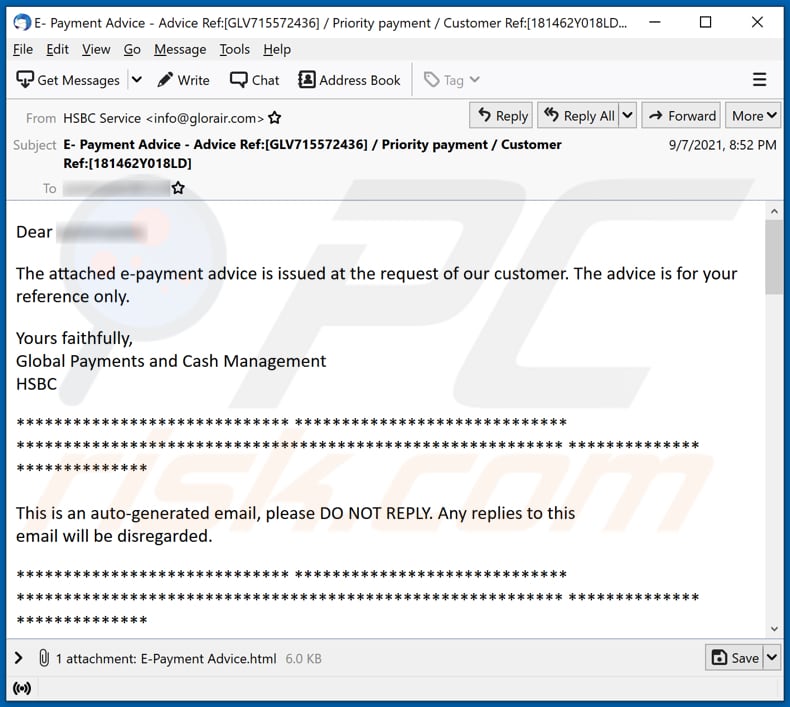
HSBC E-Payment Advice phishing email in detail
This phishing email is disguised as a letter from the HSBC bank regarding electronic payment advice (EPA) issued at the request of the customer. It has the "E-Payment Advice.html" file (its name may be different in other email variants) attached to it.
The file attached to this email asks visitors to enter the email address and password to view its contents. The entered information is sent to cybercriminals. Stolen login credentials could be misused to send this scam to people in the contacts list, deliver malware, access all emails, and for other malicious purposes.
It is important not to use the same login credentials for multiple accounts - scammers might try to use stolen information to access other accounts, which could lead to other problems like identity theft, monetary loss, etc.
| Name | HSBC E-Payment Advice Email Scam |
| Threat Type | Phishing, Scam, Social Engineering, Fraud |
| Fake Claim | Electronic payment advice has been issued at the request of a customer |
| Disguise | Letter from the HSBC bank |
| Symptoms | Unauthorized online purchases, changed online account passwords, identity theft, illegal access of the computer. |
| Distribution methods | Deceptive emails, rogue online pop-up ads, search engine poisoning techniques, misspelled domains. |
| Damage | Loss of sensitive private information, monetary loss, identity theft. |
| Malware Removal (Windows) |
To eliminate possible malware infections, scan your computer with legitimate antivirus software. Our security researchers recommend using Combo Cleaner. Download Combo CleanerTo use full-featured product, you have to purchase a license for Combo Cleaner. 7 days free trial available. Combo Cleaner is owned and operated by RCS LT, the parent company of PCRisk.com. |
Phishing emails in general
Phishing emails look like letters from legitimate entities (for example, they contain logos of existing companies). They are used to extract personal information. More examples of similar emails are "Storage Server Failure" and "DHL Express Shipment Confirmation". It is important to know that emails can be malicious.
How do spam campaigns infect computers?
Emails used to deliver malicious software (for example, ransomware, Trojans) contain website links or attachments. Recipients infect computers by downloading and opening malicious Microsoft Office or PDF documents, JavaScript files, archive files (like ZIP, RAR), executable files like EXE, or other files.
Malicious documents opened with Microsoft Office 2010 and later do not infect computers unless users enable macros commands (editing/content). Although, documents opened with older MS Office versions infect computers without asking any permission.
How to avoid installation of malware?
Irrelevant emails received from unknown addresses and containing website links or attachments should be ignored. Programs, files should be downloaded only from legitimate, reliable sources such as official websites and direct links. Installed software has to be updated or activated with tools provided by its official developer.
The operating system should have a reputable antivirus or anti-spyware software installed on it. It is advisable to scan the operating system for threats regularly. If you've already opened malicious attachments, we recommend running a scan with Combo Cleaner Antivirus for Windows to automatically eliminate infiltrated malware.
Appearance of the HSBC E-Payment Advice email scam (GIF):
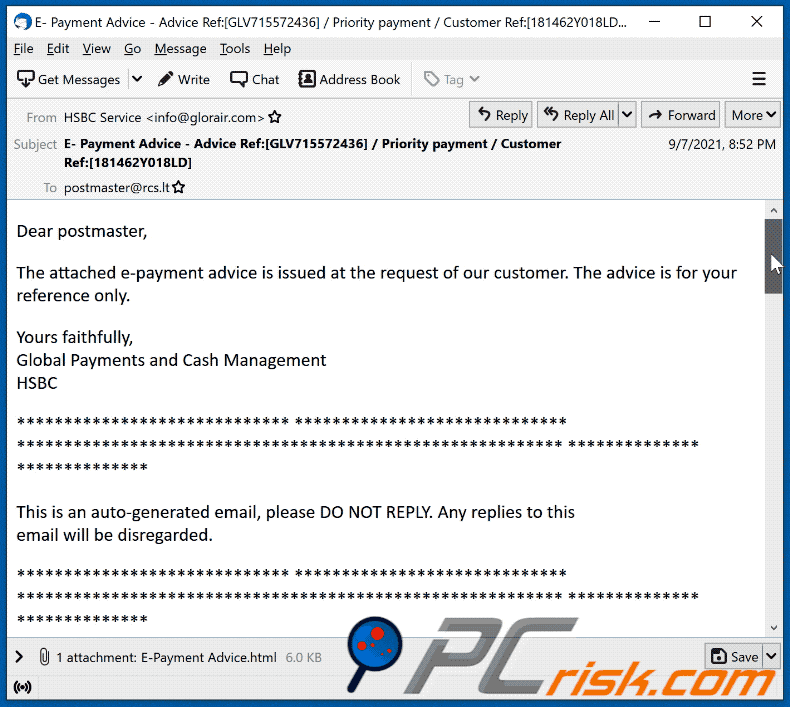
Text presented in the HSBC E-Payment Advice email scam:
Subject: E- Payment Advice - Advice Ref:[GLV715572436] / Priority payment / Customer Ref:[181462Y018LD]
Dear ********,
The attached e-payment advice is issued at the request of our customer. The advice is for your reference only.
Yours faithfully,
Global Payments and Cash Management
HSBC*******************************************************************
This is an auto-generated email, please DO NOT REPLY. Any replies to this
email will be disregarded.*******************************************************************
Security tips
1. Install virus detection software and personal firewall on your computer. This software needs to be updated regularly to ensure you have the latest protection.
2. To prevent viruses or other unwanted problems, do not open attachments from unknown or non-trustworthy sources.
3. If you discover any unusual activity, please contact the remitter of this payment as soon as possible.*******************************************************************
This e-mail is confidential. It may also be legally privileged.
If you are not the addressee you may not copy, forward, disclose
or use any part of it. If you have received this message in error,
please delete it and all copies from your system and notify the
sender immediately by return e-mail.Internet communications cannot be guaranteed to be timely,
secure, error or virus-free. The sender does not accept liability
for any errors or omissions.
*******************************************************************"SAVE PAPER - THINK BEFORE YOU PRINT!"Dear Sir/Madam,
The attached payment advice is issued at the request of our customer. The advice is for your reference only.
Yours faithfully,
Global Payments and Cash Management
HSBC
Website used to trick visitors into providing email account login credentials:
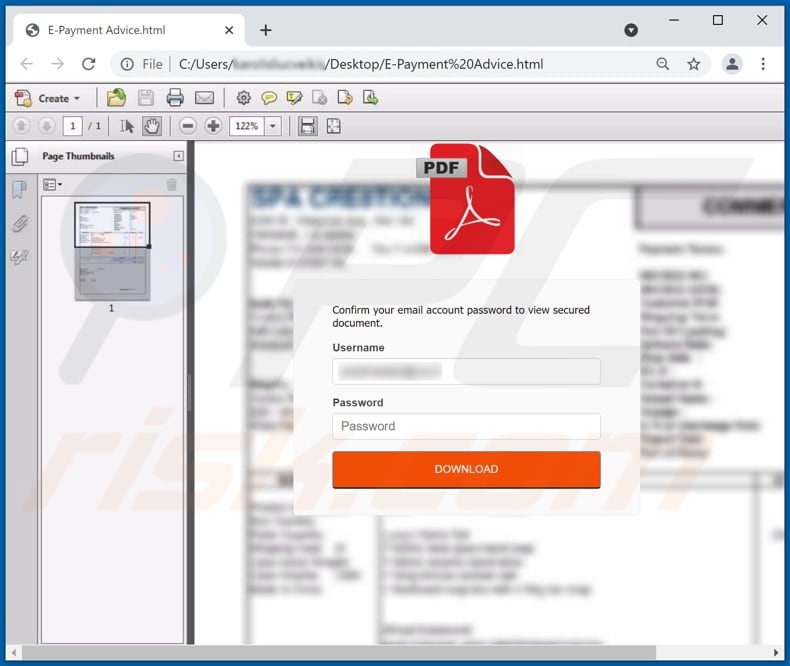
Other examples of an emails from "HSBC E-Payment Advice" spam campaign:
Sample 1:
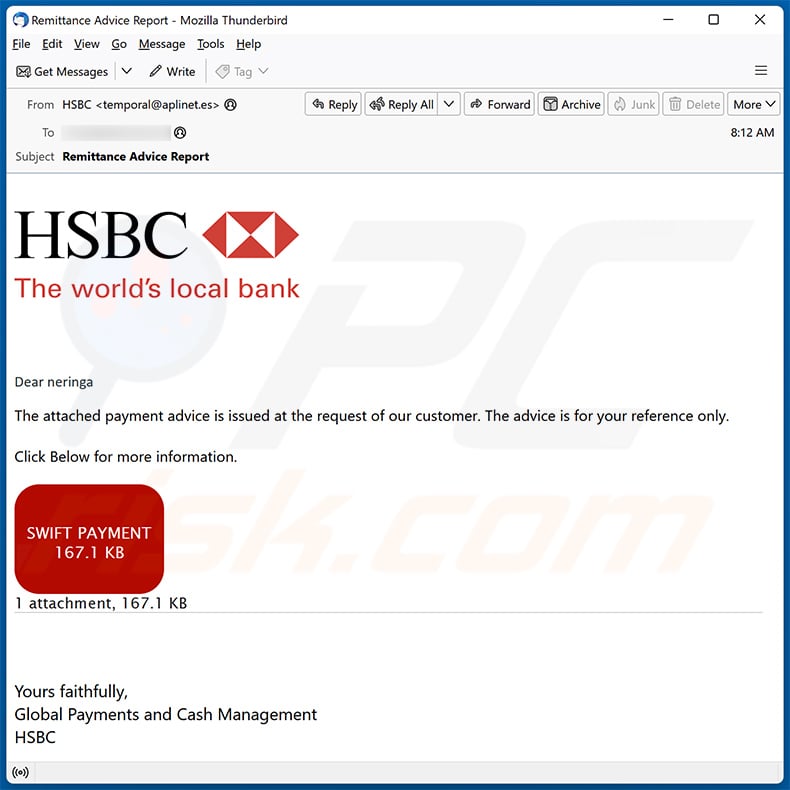
Text presented within:
Subject: Remittance Advice Report
Dear -
The attached payment advice is issued at the request of our customer. The advice is for your reference only.Click Below for more information.
SWIFT PAYMENT
167.1 KB1 attachment, 167.1 KB
Yours faithfully,
Global Payments and Cash Management
HSBC
Sample 2:
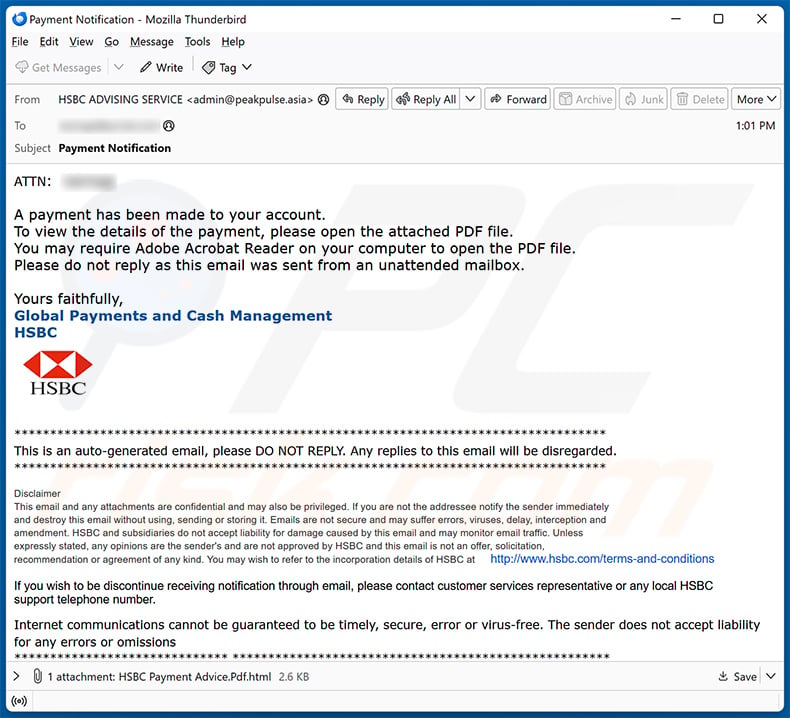
Text presented within:
Subject: Payment Notification
ATTN: -
A payment has been made to your account.
To view the details of the payment, please open the attached PDF file.
You may require Adobe Acrobat Reader on your computer to open the PDF file.
Please do not reply as this email was sent from an unattended mailbox.Yours faithfully,
Global Payments and Cash Management
HSBC
Screenshot of the attached HTML document designed for phishing purposes:
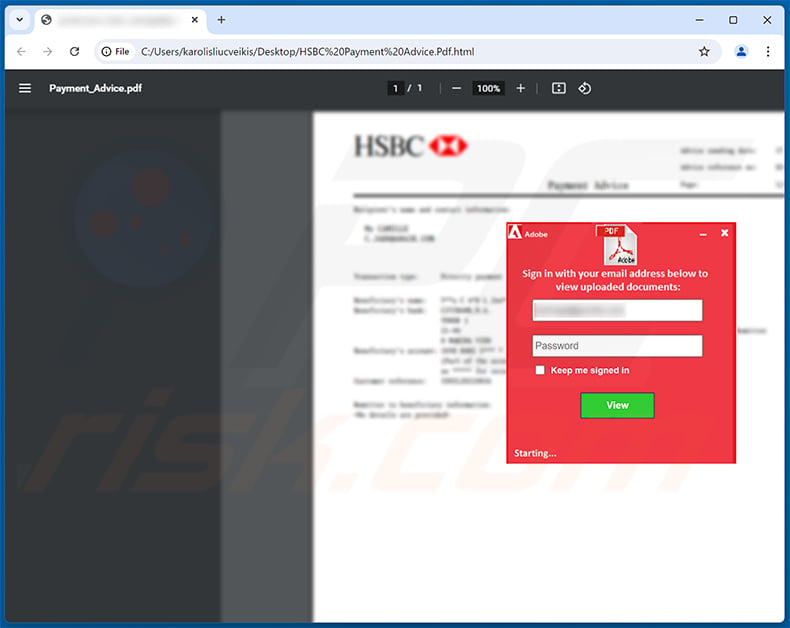
Sample 3:
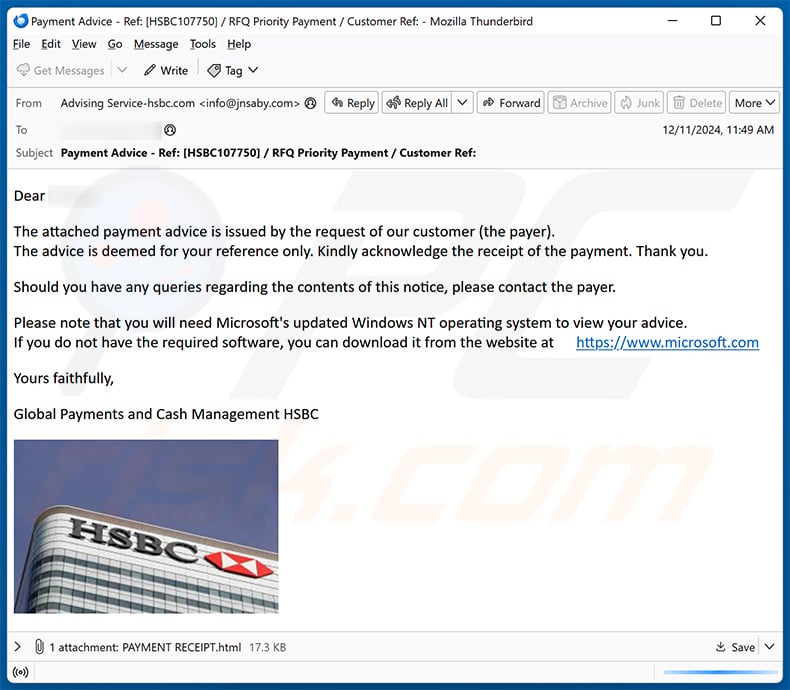
Text presented within:
Subject: Payment Advice - Ref: [HSBC107750] / RFQ Priority Payment / Customer Ref:
Dear - ,
The attached payment advice is issued by the request of our customer (the payer).
The advice is deemed for your reference only. Kindly acknowledge the receipt of the payment. Thank you.Should you have any queries regarding the contents of this notice, please contact the payer.
Please note that you will need Microsoft's updated Windows NT operating system to view your advice.
If you do not have the required software, you can download it from the website at hxxps://www.microsoft.comYours faithfully,
Global Payments and Cash Management HSBC
Screenshot of the attached HTML file used for phishing purposes:
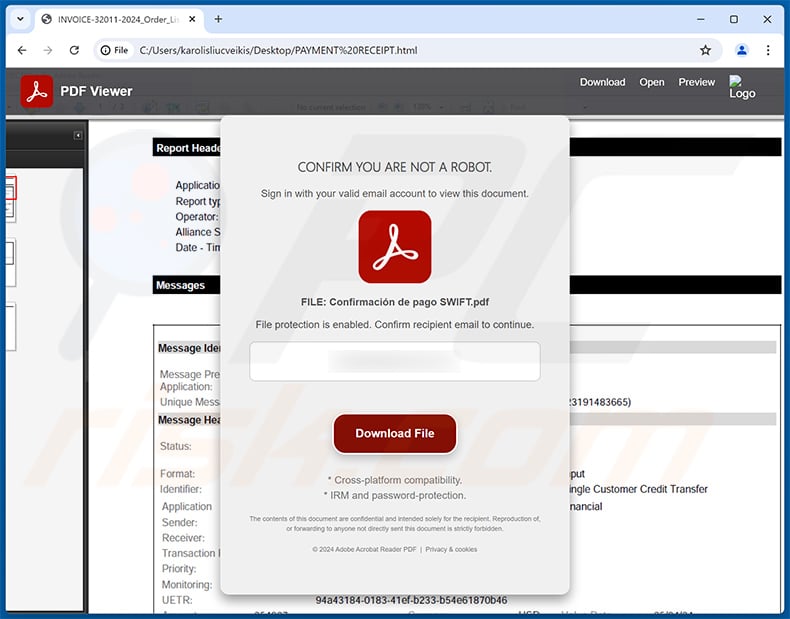
Sample 4:
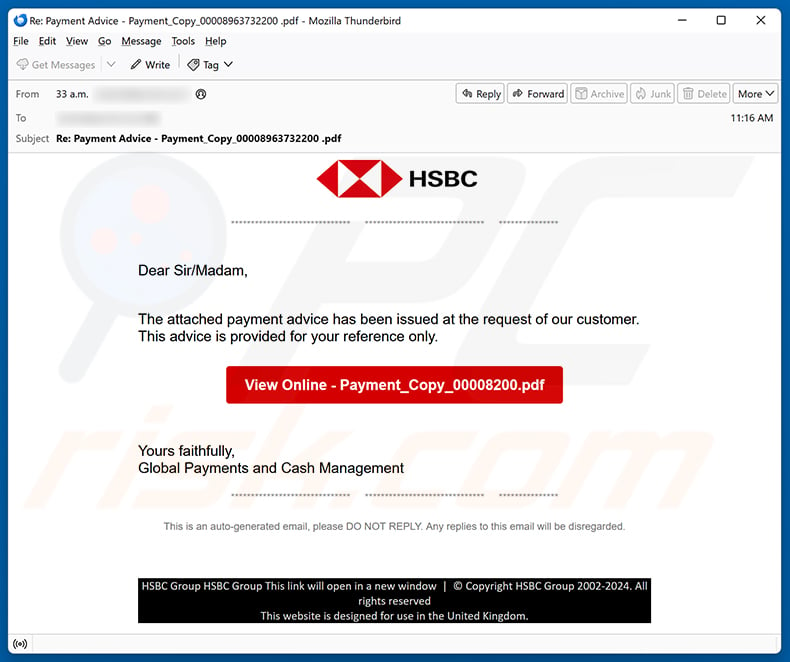
Text presented within:
Subject: Re: Payment Advice - Payment_Copy_00008963732200 .pdf
HSBC
Dear Sir/Madam,
The attached payment advice has been issued at the request of our customer. This advice is provided for your reference only.
View Online - Payment_Copy_00008200.pdfYours faithfully,
Global Payments and Cash ManagementThis is an auto-generated email, please DO NOT REPLY. Any replies to this email will be disregarded.
HSBC Group HSBC Group This link will open in a new window | © Copyright HSBC Group 2002-2024. All rights reserved
This website is designed for use in the United Kingdom.
Screenshot of the promoted phishing site:
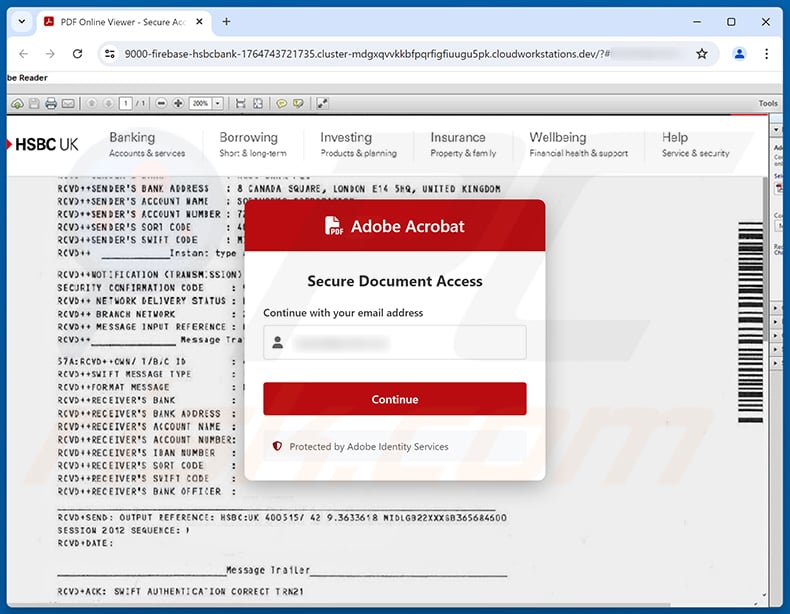
Instant automatic malware removal:
Manual threat removal might be a lengthy and complicated process that requires advanced IT skills. Combo Cleaner is a professional automatic malware removal tool that is recommended to get rid of malware. Download it by clicking the button below:
DOWNLOAD Combo CleanerBy downloading any software listed on this website you agree to our Privacy Policy and Terms of Use. To use full-featured product, you have to purchase a license for Combo Cleaner. 7 days free trial available. Combo Cleaner is owned and operated by RCS LT, the parent company of PCRisk.com.
Quick menu:
- What is HSBC E-Payment Advice spam?
- Types of malicious emails.
- How to spot a malicious email?
- What to do if you fell for an email scam?
Types of malicious emails:
![]() Phishing Emails
Phishing Emails
Most commonly, cybercriminals use deceptive emails to trick Internet users into giving away their sensitive private information, for example, login information for various online services, email accounts, or online banking information.
Such attacks are called phishing. In a phishing attack, cybercriminals usually send an email message with some popular service logo (for example, Microsoft, DHL, Amazon, Netflix), create urgency (wrong shipping address, expired password, etc.), and place a link which they hope their potential victims will click on.
After clicking the link presented in such email message, victims are redirected to a fake website that looks identical or extremely similar to the original one. Victims are then asked to enter their password, credit card details, or some other information that gets stolen by cybercriminals.
![]() Emails with Malicious Attachments
Emails with Malicious Attachments
Another popular attack vector is email spam with malicious attachments that infect users' computers with malware. Malicious attachments usually carry trojans that are capable of stealing passwords, banking information, and other sensitive information.
In such attacks, cybercriminals' main goal is to trick their potential victims into opening an infected email attachment. To achieve this goal, email messages usually talk about recently received invoices, faxes, or voice messages.
If a potential victim falls for the lure and opens the attachment, their computers get infected, and cybercriminals can collect a lot of sensitive information.
While it's a more complicated method to steal personal information (spam filters and antivirus programs usually detect such attempts), if successful, cybercriminals can get a much wider array of data and can collect information for a long period of time.
![]() Sextortion Emails
Sextortion Emails
This is a type of phishing. In this case, users receive an email claiming that a cybercriminal could access the webcam of the potential victim and has a video recording of one's masturbation.
To get rid of the video, victims are asked to pay a ransom (usually using Bitcoin or another cryptocurrency). Nevertheless, all of these claims are false - users who receive such emails should ignore and delete them.
How to spot a malicious email?
While cyber criminals try to make their lure emails look trustworthy, here are some things that you should look for when trying to spot a phishing email:
- Check the sender's ("from") email address: Hover your mouse over the "from" address and check if it's legitimate. For example, if you received an email from Microsoft, be sure to check if the email address is @microsoft.com and not something suspicious like @m1crosoft.com, @microsfot.com, @account-security-noreply.com, etc.
- Check for generic greetings: If the greeting in the email is "Dear user", "Dear @youremail.com", "Dear valued customer", this should raise suspiciousness. Most commonly, companies call you by your name. Lack of this information could signal a phishing attempt.
- Check the links in the email: Hover your mouse over the link presented in the email, if the link that appears seems suspicious, don't click it. For example, if you received an email from Microsoft and the link in the email shows that it will go to firebasestorage.googleapis.com/v0... you shouldn't trust it. It's best not to click any links in the emails but to visit the company website that sent you the email in the first place.
- Don't blindly trust email attachments: Most commonly, legitimate companies will ask you to log in to their website and to view any documents there; if you received an email with an attachment, it's a good idea to scan it with an antivirus application. Infected email attachments are a common attack vector used by cybercriminals.
To minimise the risk of opening phishing and malicious emails we recommend using Combo Cleaner Antivirus for Windows.
Example of a spam email:

What to do if you fell for an email scam?
- If you clicked on a link in a phishing email and entered your password - be sure to change your password as soon as possible. Usually, cybercriminals collect stolen credentials and then sell them to other groups that use them for malicious purposes. If you change your password in a timely manner, there's a chance that criminals won't have enough time to do any damage.
- If you entered your credit card information - contact your bank as soon as possible and explain the situation. There's a good chance that you will need to cancel your compromised credit card and get a new one.
- If you see any signs of identity theft - you should immediately contact the Federal Trade Commission. This institution will collect information about your situation and create a personal recovery plan.
- If you opened a malicious attachment - your computer is probably infected, you should scan it with a reputable antivirus application. For this purpose, we recommend using Combo Cleaner Antivirus for Windows.
- Help other Internet users - report phishing emails to Anti-Phishing Working Group, FBI’s Internet Crime Complaint Center, National Fraud Information Center and U.S. Department of Justice.
Frequently Asked Questions (FAQ)
Why did I receive this email?
Spam emails are not personal; thousands of users receive identical letters.
I have provided my personal information when tricked by this spam email, what should I do?
If you have provided log-in credentials - immediately change the passwords of all possibly compromised accounts and inform their official support. And if the disclosed data was of a different personal nature (e.g., ID card details, credit card numbers, etc.) - inform the relevant authorities without delay.
I have read a spam email but didn't open the attachment, is my computer infected?
No, merely reading an email will not initiate any system infection processes. Instead, malware download/installation chains are triggered when the attached files or links included in these letters are opened/clicked.
I have downloaded and opened a file attached to a spam email, is my computer infected?
If it was an executable - most likely, yes - your system was infected. However, you might have avoided initiating any infection chains if it was a document (.doc, .xls, .pdf, etc.). These formats may require additional user interactions (e.g., enabling macro commands) to begin downloading/installing malware.
Will Combo Cleaner remove malware infections present in email attachments?
Yes, Combo Cleaner is capable of detecting and eliminating nearly all known malware infections. However, it must be emphasized that running a full system scan is key - since sophisticated malicious software usually hides deep within systems.
Share:

Tomas Meskauskas
Expert security researcher, professional malware analyst
I am passionate about computer security and technology. I have an experience of over 10 years working in various companies related to computer technical issue solving and Internet security. I have been working as an author and editor for pcrisk.com since 2010. Follow me on Twitter and LinkedIn to stay informed about the latest online security threats.
PCrisk security portal is brought by a company RCS LT.
Joined forces of security researchers help educate computer users about the latest online security threats. More information about the company RCS LT.
Our malware removal guides are free. However, if you want to support us you can send us a donation.
DonatePCrisk security portal is brought by a company RCS LT.
Joined forces of security researchers help educate computer users about the latest online security threats. More information about the company RCS LT.
Our malware removal guides are free. However, if you want to support us you can send us a donation.
Donate
▼ Show Discussion